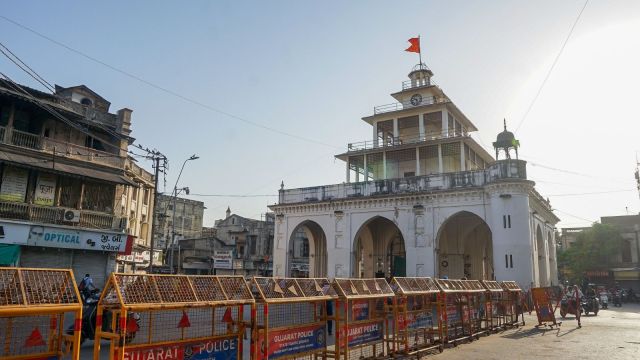16th-century Mandvi gate in Vadodara on shaky ground: ASI team rushed in to contain damage; political blame game on
Speaking to The Indian Express, Executive Engineer of the Futuristic Cell of the VMC said that the VMC had added “temporary support” to the structure after weakness was observed earlier in March
 A team of ASI officials from Gandhinagar arrived at the spot and made a primary assessment of the structure (Express Photo)
A team of ASI officials from Gandhinagar arrived at the spot and made a primary assessment of the structure (Express Photo)With Vadodara’s historic Mandvi gate — known as the heart of the city — on the verge of crumbling with recent instances of column crushing, a political blame game ensued on Tuesday even as officials of the Archaeological Survey of India (ASI) were rushed from the state capital to take stock of the 16th-century structure.
On Tuesday, Congress leaders, including city Congress President Rutvij Joshi and Opposition Leader in the Vadodara Municipal Corporation (VMC) Chandrakant Shrivastav, joined the protesting locals at Mandvi gate where Mahant Hariom Vyas of the Vitthalnathji Temple has been standing barefoot since Monday seeking immediate intervention. Soon after, Vadodara BJP MP Hemang Joshi as well as Raopura MLA and Chief Whip of Gujarat Assembly, Balkrishna Shukla, also arrived at the spot.
Even as the Congress blamed the Bharatiya Janata Party (BJP) for the deteriorating condition of the structure, Shukla and Joshi were seen assuring locals that immediate action would be taken in the matter.
 Mandvi Gate is the north gate of the Royal Enclosure for Baroda State and is one of the major landmarks in Vadodara (Express)
Mandvi Gate is the north gate of the Royal Enclosure for Baroda State and is one of the major landmarks in Vadodara (Express)
A team of ASI officials from Gandhinagar arrived at the spot and made a primary assessment of the structure. The ASI experts termed the structure as “fragile” with “immediate need to restore” it. The ASI has advised the local authorities to restrict movement of individuals through the gate in order to prevent “vibrations from damaging the structure” and also “to prevent any casualty in case of it giving way”.
Speaking to The Indian Express, Executive Engineer of the Futuristic Cell of the VMC — which looks after the structure — Rajendra Vasava said that the VMC had added “temporary support” to the structure after weakness was observed earlier in March.
Vasava said, “The structure has been weakening and we have added metal beams to support it as an immediate step. Despite that, the structure is witnessing column crushing, which happens due to aging. The structure has previously been repaired but we are looking into the details of what process was undertaken in that time as I have recently taken charge of the department.”
As per records of the VMC, it was in August 2017 that the Standing Committee had passed a resolution to restore the Mandvi gate as part of the Swarnim Jayanti Mukhyamantri Sehri Vikas Yojana for an estimated budget of Rs 1.25 crore. The work order was handed out to Savani Construction Private Limited– presently known as Savani Heritage Conservation Private Limited, which is also currently working on the restoration of the masonry dome of the Faculty of Arts of MS University.
Shukla, who has been leading a movement in the city for heritage conservation since 2023, said, “The Mandvi gate is the identity of Vadodara since the inception of the city. We have spoken to the Archaeological Survey of India (ASI) and are also coordinating with the Futuristic Cell of the VMC, the District Collector, and the Prant Officer to arrive at a solution to this problem….”
 Situated at the centre of the walled city, the gate was built by Sultan Muzaffar (1511-26 AD) and renovated in 1736 AD by the then Governor, Malharoa Maloji, under the orders of Damaji Roa II (Express)
Situated at the centre of the walled city, the gate was built by Sultan Muzaffar (1511-26 AD) and renovated in 1736 AD by the then Governor, Malharoa Maloji, under the orders of Damaji Roa II (Express)
Congress leader Shrivastava, on Monday, said, “The BJP should feel ashamed that they speak of religion but a spiritual leader is standing under the Mandvi gate without footwear in protest… The historical structures of the city are crumbling one by one and the VMC is being a mute spectator.”
Retorting to the allegations, BJP MP Joshi said, “The Mahant has said that he is performing a tapp (spiritual penance) and not protesting against anyone. The intention of the Mahant is not to politicise the issue but to draw attention to resolve the problem…”
About the Mandvi gate
Mandvi Gate is the north gate of the Royal Enclosure for Baroda State and is one of the major landmarks in Vadodara. Mandvi means mandapa (Sanskrit word, meaning pillared hall). Situated at the centre of the walled city, the gate was built by Sultan Muzaffar (1511-26 AD) and renovated in 1736 AD by the then Governor, Malharoa Maloji, under the orders of Damaji Roa II. Later, in 1856 AD, Ganpatrao Gaekwad added more storeys. Now it is a four-storied concrete structure with a clock fitted on the top. On special occasions like festivals and cultural events, the gate is illuminated with colourful lights.







